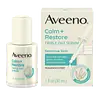What's inside
What's inside
 Key Ingredients
Key Ingredients

 Benefits
Benefits

 Ingredients Side-by-side
Ingredients Side-by-side

Water
Skin ConditioningGlycerin
HumectantButylene Glycol
HumectantBis-PEG-18 Methyl Ether Dimethyl Silane
EmollientIsodecyl Neopentanoate
EmollientPentaerythrityl Tetraethylhexanoate
EmollientEthylhexylglycerin
Skin ConditioningPhenoxyethanol
PreservativeAmmonium Acryloyldimethyltaurate/Vp Copolymer
Chlorphenesin
AntimicrobialDimethicone
EmollientSuccinoglycan
Skin ConditioningChrysanthemum Parthenium Flower/Leaf/Stem Juice
AntioxidantAvena Sativa Kernel Flour
AbrasiveAvena Sativa Kernel Oil
Skin ConditioningAcrylates/C10-30 Alkyl Acrylate Crosspolymer
Emulsion StabilisingDimethiconol
EmollientSodium Hydroxide
BufferingAvena Sativa Kernel Extract
AbrasiveWater, Glycerin, Butylene Glycol, Bis-PEG-18 Methyl Ether Dimethyl Silane, Isodecyl Neopentanoate, Pentaerythrityl Tetraethylhexanoate, Ethylhexylglycerin, Phenoxyethanol, Ammonium Acryloyldimethyltaurate/Vp Copolymer, Chlorphenesin, Dimethicone, Succinoglycan, Chrysanthemum Parthenium Flower/Leaf/Stem Juice, Avena Sativa Kernel Flour, Avena Sativa Kernel Oil, Acrylates/C10-30 Alkyl Acrylate Crosspolymer, Dimethiconol, Sodium Hydroxide, Avena Sativa Kernel Extract
Water
Skin ConditioningPropanediol
SolventGlycerin
Humectant1,2-Hexanediol
Skin ConditioningSaccharide Isomerate
HumectantPanthenol
Skin ConditioningSodium PCA
HumectantCarbomer
Emulsion StabilisingAllantoin
Skin ConditioningCentella Asiatica Leaf Extract
Skin ConditioningOctyldodecanol
EmollientSodium Hydroxide
BufferingBiosaccharide Gum-1
HumectantPolyglyceryl-3 Methylglucose Distearate
EmulsifyingEthylhexylglycerin
Skin ConditioningCeramide NP
Skin ConditioningXanthan Gum
EmulsifyingHydroxyethylcellulose
Emulsion StabilisingCitric Acid
BufferingSodium Citrate
BufferingButylene Glycol
HumectantCaprylyl Glycol
EmollientHydrolyzed Gardenia Florida Extract
AntioxidantHydrolyzed Malt Extract
Skin ConditioningHydrolyzed Viola Tricolor Extract
Skin ProtectingHyaluronic Acid
HumectantHydrolyzed Hyaluronic Acid
HumectantSodium Hyaluronate
HumectantWater, Propanediol, Glycerin, 1,2-Hexanediol, Saccharide Isomerate, Panthenol, Sodium PCA, Carbomer, Allantoin, Centella Asiatica Leaf Extract, Octyldodecanol, Sodium Hydroxide, Biosaccharide Gum-1, Polyglyceryl-3 Methylglucose Distearate, Ethylhexylglycerin, Ceramide NP, Xanthan Gum, Hydroxyethylcellulose, Citric Acid, Sodium Citrate, Butylene Glycol, Caprylyl Glycol, Hydrolyzed Gardenia Florida Extract, Hydrolyzed Malt Extract, Hydrolyzed Viola Tricolor Extract, Hyaluronic Acid, Hydrolyzed Hyaluronic Acid, Sodium Hyaluronate
 Reviews
Reviews

Ingredients Explained
These ingredients are found in both products.
Ingredients higher up in an ingredient list are typically present in a larger amount.
Butylene Glycol (or BG) is used within cosmetic products for a few different reasons:
Overall, Butylene Glycol is a safe and well-rounded ingredient that works well with other ingredients.
Though this ingredient works well with most skin types, some people with sensitive skin may experience a reaction such as allergic rashes, closed comedones, or itchiness.
Learn more about Butylene GlycolEthylhexylglycerin (we can't pronounce this either) is commonly used as a preservative and skin softener. It is derived from glyceryl.
You might see Ethylhexylglycerin often paired with other preservatives such as phenoxyethanol. Ethylhexylglycerin has been found to increase the effectiveness of these other preservatives.
Glycerin is already naturally found in your skin. It helps moisturize and protect your skin.
A study from 2016 found glycerin to be more effective as a humectant than AHAs and hyaluronic acid.
As a humectant, it helps the skin stay hydrated by pulling moisture to your skin. The low molecular weight of glycerin allows it to pull moisture into the deeper layers of your skin.
Hydrated skin improves your skin barrier; Your skin barrier helps protect against irritants and bacteria.
Glycerin has also been found to have antimicrobial and antiviral properties. Due to these properties, glycerin is often used in wound and burn treatments.
In cosmetics, glycerin is usually derived from plants such as soybean or palm. However, it can also be sourced from animals, such as tallow or animal fat.
This ingredient is organic, colorless, odorless, and non-toxic.
Glycerin is the name for this ingredient in American English. British English uses Glycerol/Glycerine.
Learn more about GlycerinSodium Hydroxide is also known as lye or caustic soda. It is used to adjust the pH of products; many ingredients require a specific pH to be effective.
In small amounts, sodium hydroxide is considered safe to use. However, large amounts may cause chemical burns due to its high alkaline.
Your skin has a natural pH and acid mantle. This acid mantle helps prevent harmful bacteria from breaking through. The acid mantle also helps keep your skin hydrated.
"Alkaline" refers to a high pH level. A low pH level would be considered acidic.
Learn more about Sodium HydroxideWater. It's the most common cosmetic ingredient of all. You'll usually see it at the top of ingredient lists, meaning that it makes up the largest part of the product.
So why is it so popular? Water most often acts as a solvent - this means that it helps dissolve other ingredients into the formulation.
You'll also recognize water as that liquid we all need to stay alive. If you see this, drink a glass of water. Stay hydrated!
Learn more about Water